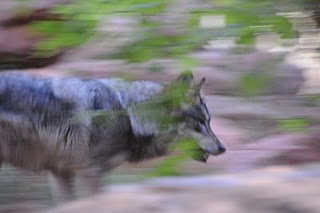 JUNE 2011 WALLOW FIRE & MEXICAN GREY WOLVES UPDATE LINK: http://www.fws.gov/southwest/es/mexicanwolf/pdf/MWWFU_6-13-11.pdf
JUNE 2011 WALLOW FIRE & MEXICAN GREY WOLVES UPDATE LINK: http://www.fws.gov/southwest/es/mexicanwolf/pdf/MWWFU_6-13-11.pdf Dec. 7, 2010 Arizona Game and Fish reaffirms commitment to Mexican wolf conservation Department continues day-to-day management as it seeks to play greater role in conservation effort PHOENIX – On Dec. 4, the Arizona Game and Fish Commission voted to support Congressional actions to delist the gray wolf from protection under the Endangered Species Act. The commission reaffirmed its strong commitment to Mexican wolf conservation, but recognized that progress on the program had been stalled since 2001 due to the current federal process that guides Mexican wolf conservation and the impact of unceasing environmental litigation. “The current Mexican wolf conservation program is in gridlock, and while we support the Endangered Species Act, we recognize that in the case of the wolf, it has helped create an impasse that could lead to the demise of the species in the wild,” says Terry Johnson, Ph.D., endangered species coordinator of the Game and Fish Department. “The discussion that led to the Game and Fish Commission’s decision recognizes that it is both unfortunate, and ironic that successful Mexican wolf conservation may hinge on removing it from the Congressional act intended to help restore it.” Through the commission’s action, they anticipate that the Game and Fish Department will become even more heavily involved in planning the future of the species and the day-to-day activities in a more affordable, efficient and effective manner “Continuous litigation on wildlife conservation efforts, including wolves, has left wildlife management decisions to the judiciary instead of with the experts – the natural resources agencies. This litigation-driven bureaucratic process also drives up the cost of conservation, making Mexican wolf conservation unaffordable for anyone,” added Johnson. The commission discussed that Congressional involvement is necessary to break the regulatory and litigious gridlock that Mexican wolf conservation has endured for many years before the demise of the species in the wild. Federal partnerships have been, and will continue to be, essential to continuing Mexican wolf conservation, and the commission invites all stakeholders to the table who are willing to participate in seeking solutions that will lead to effective, productive Mexican wolf conservation. Wolves in Arizona will continue to be protected wildlife through state statutes. Arizona’s involvement in Mexican wolf conservation began in the mid-1980s, with exploration of the feasibility of reintroducing wolves in Arizona and New Mexico. In 1996, the U.S. Fish and Wildlife Service selected the Blue Range area in east-central Arizona as the reintroduction site, and the first 11 captive-reared wolves were released there in 1998. The Blue Range Wolf Recovery Area encompasses east-central Arizona and west-central New Mexico. The Fort Apache Indian Reservation also plays an integral part in the reintroduction effort. TO LEARN MORE, VISIT: http://www.azgfd.gov/w_c/es/mexican_wolf.shtml












